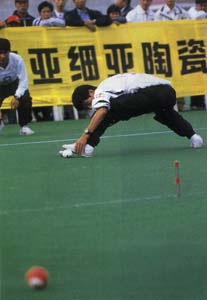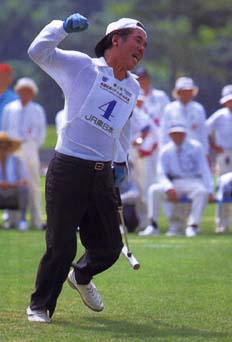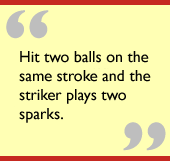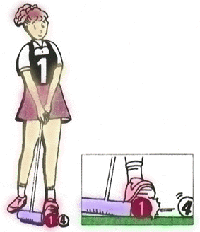
|
Back to |
| The Front Page |
| The Game |
|
Gateball: Croquet's missing link? by James Hawkins photos courtesy of the Japan Gateball Union Posted March 15, 2002 |
|
|||||||||
The editor of The Croquet Gazette has written in the January 2002 issue the best coherent overview to date of the phenomenal wicket game created in Asia and now spreading to the West. Gateball has already accomplished what some organizers in the biggest croquet nations hope to achieve through Golf Croquet. Because it is vastly more space-efficient than Association Croquet and can be played on indifferent surfaces, the game would seem to be a sensible strategy to introduce wicket sports more widely to the public. Sceptics say that "Backyard Croquet" or "Garden Croquet" already does that; they worry that the oh-so-plebeian game of Gateball will surpass and eclipse their favourite - and decidedly more elegant - sport. But like it or not, Gateball is already a huge success. If it hasn't already arrived, it will come soon to a park in your town. This is the story of how Gateball has attracted the popular following croquet organizers have only dreamed of.
The aftermath of the Second World War saw Japan rebuilding itself as a nation, not just in the bricks and mortar of Hiroshima, but in every aspect of its economic, industrial and cultural life.
In 1947, Eiji Suzuki came up with the idea of a sport for the young people of Hokkaido. Toys were scarce, and he set about finding a team game with the meagre facilities on offer. His surprising model was Croquet, and the result was to become Gateball.
Half a century on, Gateball's spread has been impressive. Figures vary according to sources, though the most reliable indicate two million players in Japan, and a further five million in China. The arithmetic is easy for putting this in perspective with the West: Japan's population is almost exactly double that of the UK, and half that of the USA. Bearing in mind that Gateball only really took hold in 1964 (post Tokyo Olympics), and the governing body, the Japan Gateball Union, was formed as recently as 1984, this rate of growth is very impressive indeed.
The game
Gateball's roots seem to be in some sort of version of 19th century 'tight croquet'. The main point of departure from Croquet is in the fact that there are ten numbered balls. Players wear bibs numbered 1 to 10, and Evens (white) play Odds (red). Play is in numerical sequence.

|

|
The croquet stroke is obsolete. It is replaced with the evocatively named "spark". A foot is placed on the striker's ball, with the sparked ball in contact. The striker's ball is struck so that the object ball moves, but the striker's must remain under the foot. The variety of the croquet stroke, with splits and stops and rolls, has no place in Gateball.

In Croquet, the striker's turn ends only if a croqueted ball is sent off the lawn. In Gateball, the turn ends if a ball goes off in any stroke except a spark. Sending the opponents off the lawn is a positive bonus.
When a ball is sent out of play, it may be played back on to the lawn, but it can't score, and it can't touch another ball. A team that can get all five of its opponents over the line has a big advantage.
The change with the largest impact concerns continuation shots. Run a croquet hoop and roquet (touch) the ball beyond in the same stroke, and the bonus stroke for the hoop is forfeited. In Gateball, all continuation shots may be saved up and taken together.

Hit two balls on the same stroke and the striker plays two sparks. Then the striker can play two extra shots, one after the other. Score a gate and hit another ball in the same stroke and a similar bonus is awarded.
This is where the game becomes tactical. 2, knowing that 4 plays before 1, puts 1 just beyond 4's gate. The gates are so wide that the extra bonus is always achievable if set up by a teammate. 2 places his own ball just beyond 1, on the line of 4's ricochet. 4 scores the gate and earns a bonus stroke. The ball hits 1 on the same stroke, earning a second bonus, and hits 2 earning a third. Moreover, 2 has taken position in the exact spot which will allow 4 to come to rest close to 4's next-but-one gate.
Throughout the game, the sequence of the balls is a constant consideration in tactics. 2 can shoot at 1 with impunity, knowing there are another nine turns before 1 can fight back. For the same reason, there is little point in 2 sparking 1 off the lawn. Experienced players would normally spark 1 towards 4, 6, 8 or 10, or construct a leave for 4 as above.
A significant difference between Croquet and Gateball is the time limit. All Gateball games have a time imposed, set strictly to 30 minutes. Every stroke is limited to a maximum of just ten seconds. These punitive limits mean that almost every game is decided on time. Tactics change by the minute. A team will adopt a totally different strategy at the start, at half time, and towards the end of the 30 minutes. The perfect 25-point game (three hoops per ball plus two for the peg) is almost unheard of. Despite the presence of ten players, there is surprisingly little waiting around, with an average of just two minutes between a player's successive turns.
The ethos of Gateball
It may be an uncomfortable thought to Croquet players, but Gateball seems to have been conceived as a variant of Croquet, deliberately stripped of much of its technical skill. And it's painful to see the illegitimate child of Croquet growing up to be more successful than its parent.

|
Tactics are profound, and with only ten seconds to execute each shot, it's a struggle to keep up with the play. Enter the Team Manager.
The way a Gateball court is laid out, nine players sit on benches, while the striker plays. With the outplayers sit the two Managers. These may or may not be playing captains, but act as tactical overlords. However they choose to fulfil the role, theirs is not a silent one. In the UK experiments with the game, the role of the outplayers has been a key to the essence of the game. It's rowdy.
Critics might gripe at a game that sets ten players on the lawn whose only task is to follow orders. That's nonsense. The Manager serves a useful purpose in instructing those who've perhaps not played before. With the positioning of the balls being so crucial, it is not possible for the Manager to give anything but the most rudimentary of instructions to more experienced members of the team. The duties of the Manager seem to lie, therefore, somewhere between football manager and theatrical prompt.

What is remarkable is the sort of people who play the game. Designed for children to play anywhere, it seems to have found a firm place among Japan's retired community. In a society whose Confucian ideals venerate the elderly, an activity that provides moderate exercise and, moreover, social interaction seems to have struck a chord. Daily Gateball sessions are packed, taking place in Tokyo's parks between 7.00 and 8.30 am. Like croquet, Gateball seems to have arrived at some form of coexistence with itself, where youngsters play competitively in championships, allowing senior members their leisurely morning game.
Outside Japan
Colin Fletcher from Beverley Croquet Club travelled to Tokyo last year to visit family. Acting as an unofficial emissary of the Croquet Association, he called on the Japan Gateball Union offices in the city centre. Yes, offices. Gateball seems to be big business. The JGU premises even include a rooftop carpet for outdoor play.
The evangelical zeal with which the JGU promote the game seems to be paying off. The five million Chinese players seem to be drawn from rural provinces, where Gateball has taken on the role of an inter-village Sunday cricket league. This is not to say that the Chinese don't set their sights further. The 3rd Asian Gateball Championship last year saw China take every single one of the last eight places.
Even the Japanese are in awe of the Chinese. The style of play seems to be akin to Croquet (the stick swung centre-style, unlike the Japanese golf stance). Remarkable is the unconventional, and uncomfortable, sparking style that gives the Chinese a great advantage in judging direction.
Australia sent three teams to the World Championships in Hawaii in the previous year. Fifteen of their top Croquet players took part, and even with a squad of Test veterans, they took each of the bottom three places (typically the field for such an event comprises around 700 teams - 3500 players.)
The current tally of Gateballing nations makes surprising reading. Official figures are not available, but the countries where the sport is widely played are Argentina, Australia, Bolivia, Brazil, Canada, China (including Taipei and Hong Kong), India, Indonesia, Japan, Korea, New Zealand, Paraguay, Peru, Russia, Singapore, Thailand, Uruguay, and the USA. The World Gateball Union has development in progress in several other nations. Demonstrations of the game have been staged in Mexico and Cuba. Europe is a barren land for the spread of the game so far, though it's rumoured that the next World Championships will take place in, of all places, Germany.
Gateball in Britain
The Croquet Association has been looking at several ways of introducing young people to Croquet. A number of clubs have experimented successfully with Kiwi Croquet, a New Zealand import that provides an abridged form of Croquet for schoolchildren. The CA's Development Committee has set up a Working Party to investigate the introduction of Gateball to the UK. The Group comprises Bill Sidebottom (Chairman of Development), Alan Pidcock (Chairman of Equipment), John Haslam (Southport Croquet Club Chairman), and me, as some sort of (supposed) playing expert. Alan, John and I are based at Southport, and the long-term plan is to use Gateball as a means of expanding the Club and widening its membership across age groups.
This is not to say that we see Gateball as a simplified Croquet game, and a key to promote Croquet. Gateball is not that. These are two separate games, which happen to look similar. Clubs, particularly larger clubs like Southport, have difficulty in getting full use out of their facilities without intensive recruitment. Gaining new members to the Gateball wing of the Club may permit future cross-pollination between the two sports. How or whether that works has yet to be seen.
What is clear is that the Club is not yet ready to open its doors to new Gateballers. The game is easy to learn, but the hardest starting point is to come from a croquet-playing background, and to have to unlearn all one's habits. No one is going to become a Grandmaster of Gateball after five games. And until we as members have found out what we're supposed to be doing, recruitment of newcomers is futile.
In terms of technique, what is a surprise is how shockingly difficult the game is. The balls are resin, and behave very much like snooker balls. The mallets (or sticks) are like golf putters, with solid metal heads. There is so much bounce in a ball that it's very difficult to hit anything without sending the striker's ball off. The Australians have reverted from centre-style croquet stances to side-on softball grips, in order to control the pace. Hitting straight with such a small striking face on the stick is a further challenge. Having said that, Gateball has some desirable features for club play.
It's such a great leveller, relying even less than Croquet on strength. Our first session saw two mixed teams, handicapped from 0 to 24. It was the 24 who held to key to success. A year of very occasional play seems to have made the Club into a much more socially cohesive unit. You can play indoors (the Japanese use carpets in sports halls), and you can play over the winter (witness the Southport frost-bound New Year's Day gathering).
Is it a good game? Possibly; it's sort of grown on me over the season. Will it take off in the West? I just don't know. But with seven million more of them than us, I don't expect we've heard the last of them.
[Reprinted by permission in full from The Croquet Gazette, January 2002.]